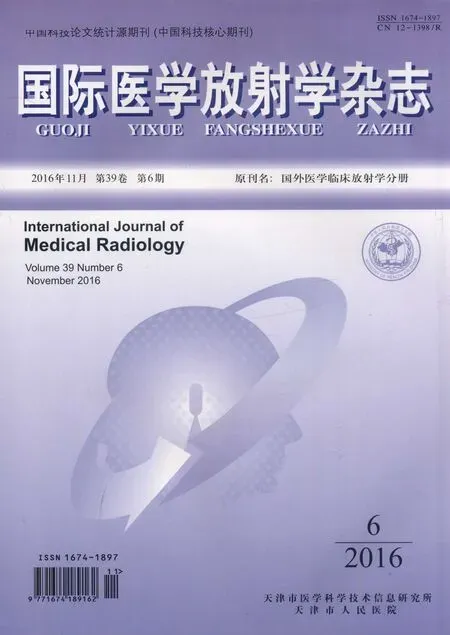神经影像技术用于创伤后应激障碍的研究进展
郎 旭 张云亭 张 权
神经影像技术用于创伤后应激障碍的研究进展
郎 旭 张云亭*张 权
创伤后应激障碍(PTSD)是个体暴露于创伤相关应激因素引起一系列严重反应的精神障碍性疾病。近年来,神经影像技术的发展使研究人员发现更多的PTSD相关大脑结构和功能的特征性改变,MRI用于PTSD的研究对观察PTSD病人的脑形态及功能尤其重要。总结神经影像技术在PTSD中的应用现状及主要发现,及其在PTSD发病机制及诊疗研究中的潜力。
创伤后应激障碍;神经影像;磁共振成像;海马;杏仁核
Int J Med Radiol,2016,39(6):615-617;653
创伤后应激障碍(post traumatic stress disorder,PTSD)最早被认为是焦虑障碍的一种,发生于暴露在死亡或严重伤害威胁的人群中,个体表现出强烈的恐惧、无助及恐慌感,后经过进一步研究,将其纳为应激相关障碍,认为它是一种持续及延迟性的心理障碍。PTSD病人往往以各种方式,包括侵入性和令人不安的回忆、梦魇及闪回,来持续反复体验其所受的创伤事件,并主动逃避与创伤相关事物,最后病人出现反应过度,其特点是入睡困难或注意力不集中,警觉和夸张的吃惊反应[1]。目前对PTSD的研究处于一个比较初级的阶段,许多神经生物学相关因素仍然只是假设或尚不确定。近年来,随着神经影像技术的发展,PTSD病人大脑结构和功能方面的改变逐渐被发现,对于了解PTSD这种对个人及社会都有潜在影响的疾病发挥着越来越大的作用。
1 PTSD的结构影像学
PTSD病人在暴露于重大创伤事件后,不同程度地出现记忆损伤现象,如选择性遗忘(近期事实)、学习能力下降、情感分离状态等。海马在学习、记忆和应激调节等方面起着至关重要的作用,尤其是人类情感和空间记忆方面,是PTSD相关的关键脑区之一[2],因此海马损伤可能导致相关情感、学习和记忆能力的缺失。事实上,大量研究表明PTSD最常见的脑结构异常就是海马体积的缩小[3]。而另有研究[4]发现经受过长期虐待的年轻PTSD病人,腹内侧前额叶皮质(ventromedial prefrontal cortex,vmPFC)体积也同样是缩小的。但是,这些结构的改变,并不意味着这些损伤是PTSD引起的,也有可能是PTSD发病的风险因素。从某种意义上来说,这些结构体积的缩小是其功能减弱的基础,这与某些PTSD的发病假说相符合:大脑皮质能力的降低,使其抑制恐惧和其他负面情绪的能力大为减弱。由这种观点来看,海马无法利用周围环境给予的安全信号,腹内侧前额叶皮质也无法适应外部创伤条件消失,导致与之相关的情绪反应无法停止。
海马涉及陈述性记忆加工和条件恐惧时对环
境的编码过程,海马与杏仁核等记忆系统有关的区域存在很强的共变关系[5],此关系与PTSD病人脑结构的改变高度相关,因此在PTSD病人脑结构的MRI研究中,海马成为重点关注对象。通过对比PTSD病人与有创伤暴露史非PTSD对照组及正常对照组的脑结构MRI数据,发现PTSD病人的海马体积出现明显缩小[6]。大量此类报道和与之相关的Meta分析[7-8],也都证实了PTSD病人的海马结构体积缩小。应用高分辨力MRI的研究,发现海马体积缩小最显著的部分位于齿状回亚区[3]。Meta分析还发现PTSD病人的海马结构体积缩小是双侧存在的[9],而且没有证据表明有男女性别差异[10]。
神经影像研究还发现PTSD病人的大脑前额叶体积缩小。Rauch等[11]采用皮质分割技术分析了PTSD病人的大脑前额叶体积,发现相当大比例的病人前扣带回嘴侧前膝部及胼胝体下皮质(包括前扣带回的腹侧及眶额皮质的后内侧)的体积缩小。最近一项对地震后幸存者的研究对比了幸存者震后当时和一段时间后的脑部MR影像,发现震后研究对象的PTSD症状越重,其左侧眶额皮质的灰质体积减低得越明显,提示此脑区的结构变化为创伤后改变[12]。
杏仁核与恐惧和理解他人的恐惧情绪有关,杏仁核的缺失会导致情感行为发生显著变化。Pavlisa等[13]报道慢性PTSD病人的右侧杏仁核体积较左侧显著缩小,这种倾向性可能是应激诱发的获得性脑可塑性改变,但也不能排除其可能是PTSD发生的诱发因素。Mollica等[14]发现PTSD病人经历的创伤/折磨事件数量与病人双侧杏仁核体积缺失具有相关性。
胼胝体是连接双侧大脑半球相应皮质区的最大白质纤维束,是两侧大脑半球信息传递的枢纽,负责处理情感、认知及其他功能在加工处理时的信号传输,PTSD病人所表现出的情绪和记忆功能紊乱可能与胼胝体损伤密切相关[15]。有Meta分析发现,儿童PTSD病人的胼胝体体积缩小,而成年PTSD病人未得出此结果,因此认为儿童PTSD病人由于胼胝体发育不成熟,在经受压力、遇到负面经历时更容易受到损伤,进而认为胼胝体体积缩小是儿童PTSD病人的独有特征[8]。然而,最近在对煤矿瓦斯爆炸后幸存的成人PTSD病人研究中发现,其胼胝体出现损伤,尤其胼胝体前部的白质纤维整合性下降[16]。
2 PTSD的神经功能成像研究
关于PTSD发病的神经机制模型[17]提示,病人的杏仁核、内侧前额叶皮质(medial prefrontal cortex, mPFC)以及海马都存在不同程度的功能失调。根据这个模型,杏仁核的过度反应导致了病人产生夸张的恐惧情绪。与之相对应的,病人vmPFC[包括喙侧前扣带回皮质(rostral anterior cingulate cortex, rACC)和额内侧回的腹侧]区域的反应降低则导致其对杏仁核的抑制作用减弱,这种反应降低情况削弱了大脑对条件性恐惧反应过程的调控。最终,海马功能的异常影响了陈述性记忆的编码、识别以及对周围环境安全性的再认过程。有研究[18]表明,背侧前扣带回皮质(dorsal anterior cingulate cortex,dACC)的高反应也对这一异常改变起到一定的作用。另外,还有研究[19]发现在PTSD及其他焦虑性疾病中,岛叶的功能出现异常改变。
杏仁核是恐惧情绪形成和表达的关键中枢,具有情绪意义的刺激会引起杏仁核电活动的强烈反应。大多数对PTSD病人杏仁核的研究,得出的一致结论是杏仁核会反应性增高。Shin等[20]在对男性退伍老兵的研究中发现,PTSD组在观看创伤相关图片时,杏仁核的激活增强。Felmingham等[21]报道了面对恐惧脸孔,相对于创伤暴露的非PTSD组以及无创伤暴露对照组,PTSD组杏仁核激活明显增高。同时有研究应用功能MRI(functional MRI,fMRI)技术发现PTSD病人的杏仁核激活增强而内侧前额叶皮质激活减弱,并发现内侧前额叶皮质的信号强度与杏仁核的信号强度呈负相关,表明在病人恐惧情绪产生和表达中杏仁核的激活程度受到内侧前额叶皮质的调控[22]。还有研究发现,杏仁核激活的程度与PTSD症状的严重程度是呈正相关的,Lanius等[23]对一组受到严重创伤6周后的病人进行MRI静息态下的扫描,结果表明后扣带回皮质/楔前叶与右侧杏仁核之间的连接强度与PTSD症状的严重程度呈正相关,而且这种相关性在排除了抑郁症状的影响后仍十分显著。
有研究者[24]运用神经功能成像方法对PTSD病人进行创伤相关图片或词语的测试时,典型的结果是vmPFC区域激活的减低甚至无激活。有研究发现PTSD病人在进行感情脸孔识别任务时,rACC激活减低乃至消失。采用功能MRI(fMRI)方法,利用情绪性斯特鲁普任务(emotional Stroop task)为刺激,发现相对于非PTSD的退伍军人,患有PTSD的退伍老兵随着一般负面词语向战争相关词语转换时,出现明显的vmPFC区去激活现象[25]。vmPFC的激活程度已被许多相关的研究证实与PTSD症状的严重程度
呈负相关[26-27]。
关于PTSD病人海马反应性的研究结果呈多样化。Molina等[28]报道了在静息态下患PTSD的退伍老兵海马区域局部脑组织葡萄糖代谢率(regional cerebral metabolic rate for glucose,rCMRglu)下降。然而,在研究者运用职业脸孔配对[29]以及静息态[30]等作为研究手段时发现了PTSD病人的海马激活增强。总而言之,海马功能异常的表现方式可能与研究者所采取的实验任务方式和分析手段密切相关。
部分研究报道了PTSD病人岛叶激活的增强。Mazza等[31]使用fMRI方法,运用负面情绪和中性情绪图片来比较2009年拉奎拉地震后幸存者中的PTSD病人组和健康对照组的激活模式,发现PTSD组在观看创伤相关图片后出现明显的左侧岛叶激活增高。还有研究[32]证实了岛叶激活与PTSD症状严重程度呈正相关。
尽管神经影像技术用于PTSD的研究在过去20年间取得了很大进展,提供了关于发病机制的大量信息,但该疾病相关的神经回路和发病机制尚不明确。神经影像技术暂不能作为PTSD的可靠诊断工具。目前应用影像技术对PTSD进行研究是为了更好地理解该疾病的发病神经机制,而不是作为一个诊断工具。由于PTSD的复杂性以及相关研究参数的变化和扫描方法及数据后处理的方式没有一致的参照标准,因此某些结果的一致性受到影响,还有待完善与克服。未来随着影像设备的硬件技术和数据分析的进步,影像多模态手段可以收集更详尽的PTSD数据,将结构、功能、神经病理生理学及治疗相结合,相互补充和印证,有助于发现病人特征性共性的脑区改变,更有利于对PTSD发病机制的进一步了解,上述局限性会被更好地解决,而神经影像技术也会在PTSD诊治方面发挥更大的作用。
[1]Smith SM,Goldstein RB,Grant BF.The association between posttraumatic stress disorder and lifetime DSM-5 psychiatric disorders among veterans:Data from the National Epidemiologic Survey on Alcohol and Related Conditions-III(NESARC-III)[J].J Psychiatr Res,2016,82:16-22.
[2]Geuze E,Vermetten E,Bremner JD.MR-based in vivo hippocampal volumetrics:2.Findings in neuropsychiatric disorders[J].Mol Psychiatry,2005,10:160-184.
[3]Wang Z,Neylan TC,Mueller SG,et al.Magnetic resonance imaging of hippocampal subfields in posttraumatic stress disorder[J].Arch Gen Psychiatry,2010,67:296-303.
[4]Morey RA,Haswell CC,Hooper SR,et al.Amygdala,hippocampus, and ventral medial prefrontal cortex volumes differ in maltreated Youth with and without chronic posttraumatic stress disorder[J]. Neuropsychopharmacology,2016,41:791-801.
[5]Zhang Q,Zhuo C,Lang X,et al.Structural impairments of hippocampus in coal mine gas explosion-related posttraumatic stress disorder[J].PLoS One,2014,9:e102042.
[6]Mueller SG,Ng P,Neylan T,et al.Evidence for disrupted gray matter structural connectivity in posttraumatic stress disorder[J].Psychiatry Res,2015,234:194-201.
[7]Meng Y,Qiu C,Zhu H,et al.Anatomical deficits in adult posttraumatic stress disorder:a meta-analysis of voxel-based morphometry studies[J].Behav Brain Res,2014,270;307-315.
[8]Karl A,Schaefer M,Malta LS,et al.A meta-analysis of structural brain abnormalities in PTSD[J].Neurosci Biobehav Rev,2006,30: 1004-1031.
[9]Smith ME.Bilateral hippocampal volume reduction in adults with post-traumatic stress disorder:a meta-analysis of structural MRI studies[J].Hippocampus,2005,15:798-807.
[10]Woon F,Hedges DW.Gender does not moderate hippocampal volume deficits in adults with posttraumatic stress disorder:a metaanalysis[J].Hippocampus,2011,21:243-252.
[11]Rauch SL,Shin LM,Segal E,et al.Selectively reduced regional cortical volumes in post-traumatic stress disorder[J].Neuroreport, 2003,14:913-916.
[12]Sekiguchi A,Sugiura M,Taki Y,et al.Brain structural changes as vulnerability factors and acquired signs of post-earthquake stress [J].Mol psychiatry,2013,18:618-623.
[13]Pavlisa G,Papa J,Pavic L,et al.Bilateral MR volumetry of the amygdala in chronic PTSD patients[J].Coll Antropol,2006,30: 565-568.
[14]Mollica RF,Lyoo IK,Chernoff MC,et al.Brain structural abnormalities and mental health sequelae in South Vietnamese ex-political detainees who survived traumatic head injury and torture[J].Arch Gen Psychiatry,2009,66:1221-1232.
[15]Jackowski AP,Douglas-Palumberi H,Jackowski M,et al.Corpus callosum in maltreated children with posttraumatic stress disorder:a diffusion tensor imaging study[J].Psychiatry Res,2008,162:256-261.
[16]Zhang Y,Li H,Lang X,et al.Abnormality of the corpus callosum in coalmine gas explosion-related posttraumatic stress disorder[J]. PLoS One,2015,10:e0121095.
[17]Rauch SL,Shin LM,Phelps EA.Neurocircuitry models of posttraumatic stress disorder and extinction:human neuroimaging research--past,present,and future[J].Biol Psychiatry,2006,60: 376-382.
[18]Fonzo GA,Simmons AN,Thorp SR,et al.Exaggerated and disconnected insular-amygdalar blood oxygenation level-dependent response to threat-related emotional faces in women with intimatepartner violence posttraumatic stress disorder[J].Biol Psychiatry,2010,68:433-441.
[19]Shin LM,Liberzon I.The neurocircuitry of fear,stress,and anxietydisorders[J].Neuropsychopharmacology,2010,35:169-191.
[20]Shin LM,Orr SP,Carson MA,et al.Regional cerebral blood flow in the amygdala and medial prefrontal cortex during traumatic imagery in male and female Vietnam veterans with PTSD[J].Arch Gen Psychiatry,2004,61:168-176.
[21]Felmingham K,Williams LM,Kemp AH,et al.Neural responses to masked fear faces:sex differences and trauma exposure in posttraumatic stress disorder[J].J Abnorm Psychol,2010,119:241-247.
[22]Shin LM,Wright CI,Cannistraro PA,et al.A functional magnetic resonance imaging study of amygdala and medial prefrontal cortex responses to overtly presented fearful faces in posttraumatic stress disorder[J].Arch Gen Psychiatry,2005,62:273-281.
[23]Lanius RA,Bluhm RL,Coupland NJ,et al.Default mode network connectivity as a predictor of post-traumatic stress disorder symptom severity in acutely traumatized subjects[J].Acta Psychiatr Scand, 2010,121:33-40.
[24]Offringa R,Handwerger Brohawn K,Staples LK,et al.Diminished rostral anterior cingulate cortex activation during trauma-unrelated emotional interference in PTSD[J].BiolMoodAnxietyDisord,2013,3:10.
[25]Shin LM,Whalen PJ,Pitman RK,et al.An fMRI study of anterior cingulate function in posttraumatic stress disorder[J].Biol Psychiatry,2001,50:932-942.
[26]Moser DA,Aue T,Suardi F,et al.The relation of general socio-emotional processing to parenting specific behavior:a study of mothers with and without posttraumatic stress disorder[J].Front Psychol, 2015,6:1575.
[27]Kim MJ,Chey J,Chung A,et al.Diminished rostral anterior cingulate activity in response to threat-related events in posttraumatic stress disorder[J].J Psychiatr Res,2008,42:268-277.
[28]Molina ME,Isoardi R,Prado MN,et al.Basal cerebral glucose distribution in long-term post-traumatic stress disorder[J].World J Biol Psychiatry,2010,11:493-501.
[29]Werner NS,Meindl T,Engel RR,et al.Hippocampal function during associative learning in patients with posttraumatic stress disorder[J]. J Psychiatr Res,2009,43:309-318.
[30]Shvil E,Sullivan GM,Schafer S,et al.Sex differences in extinction recall in posttraumatic stress disorder:a pilot fMRI study[J].Neurobiol Learn Mem,2014,113:101-108.
[31]Mazza M,Tempesta D,Pino MC,et al.Regional cerebral changes and functional connectivity during the observation of negative emotional stimuli in subjects with post-traumatic stress disorder[J].Eur Arch Psychiatry Clin Neurosci,2013,263:575-583.
[32]Carrion VG,Garrett A,Menon V,et al.Posttraumatic stress symptoms and brain function during a response-inhibition task:an fMRI study in youth[J].Depress Anxiety,2008,25:514-526.
(收稿2016-08-12)
The application status and progress of neuroimaging in post-traumatic stress disorder
LANG Xu,ZHANG Yunting,ZHANG Quan.
Department of Radiology,Tianjin Medical University General Hospital,Tianjin 300052,China
Post-traumatic stress disorder(PTSD)is a mental disorder with a series of serious reactions that can affect individuals who have been exposed to trauma-related stress factors.In recent years,neuroimaging has enabled researchers to see more PTSD-related brain structural and functional changes.MRI of PTSD is very important to observe the morphology and function of the PTSD patients’brain.We summarized neuroimaging application status of PTSD and major findings. Finally,we explored potential neuroimaging prospectives in PTSD pathogenesis and treatment.
Post traumatic stress disorders;Neuroimaging;Magnetic resonance imaging;Hippocampus;Amygdala
10.19300/j.2016.Z4592
R445.2;R741
A
天津医科大学总医院放射科,天津300052
*审校者

